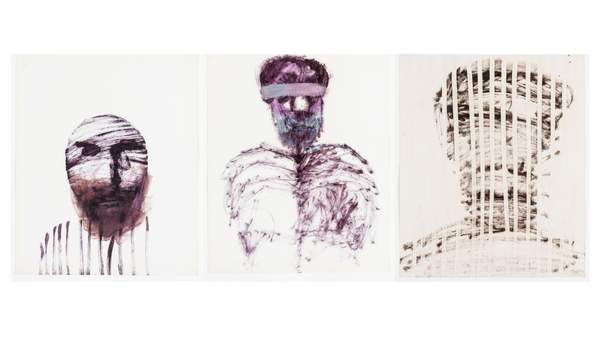Overview
Artist Sidney Nolan is famous around the world for his paintings of Australia, particularly for his portraits of the outlaw Ned Kelly riding through an idealised outback landscape, complete with ochre-red soil and clear blue skies.
But recent research by Nolan scholar Andrew Turley has revealed an almost-forgotten series of work that was inspired by a very different place: Auschwitz, the concentration camp in Poland where the Nazis murdered 1.1 million people during the Holocaust.
From July 21 to October 23, the Sydney Jewish Museum is exhibiting 50 of these paintings in a new show, Shaken to his Core: The Untold Story of Nolan's Auschwitz. This is the first time these works have ever been shown in Australia and the first time most of them have been publicly displayed anywhere in the world.
Roslyn Sugarman, Sydney Jewish Museum's Head Curator, introduces the series that Nolan made about the Holocaust — and explains what these paintings, which cover four distinct themes, reveal about one of Australia's most famous artists.
© The Sidney Nolan Trust all rights reserved, DACS / Copyright Agency 2022
ADOLF EICHMANN PORTRAITS
The exhibition opens with a series of portraits Nolan made of the war criminal Adolf Eichmann. In 1961, Eichmann was put on trial in Israel for crimes against humanity, a case that was front-page news around the world. At the time, Nolan was preparing for a trip to Auschwitz with his friend Al Alvarez, a writer who was working on a story about Nazi concentration camps for London newspaper The Observer. Nolan had been asked to illustrate the article.
In anticipation of the trip, Nolan followed Eichmann's trial closely and began painting him from photos he found in newspapers. "It's a repeat of the same face over and over again," says Sugarman. "It's easily recognisable that you're looking at Eichmann. He had a broad forehead, a receding hairline, and he wore thick, round glasses and had very thin lips."
© The Sidney Nolan Trust all rights reserved, DACS / Copyright Agency 2022
PORTRAITS OF HOLOCAUST VICTIMS
After Eichmann was sentenced to death on December 12, 1961, Nolan turned his attention to painting victims of the concentration camps. He made more than 80 portraits of Holocaust victims in a frenzied six-day spell that December. "One of the most striking heads is sort of tortured and twisted. The mouth is open and screaming," says Sugarman. "It's not a particular person, it's more an idea of a victim, perhaps an exploration of the essence of a victim."
To emphasise the sheer number of people who were killed, Sugarman has chosen to display these portraits of Holocaust victims in a large grid. "There is a mass of them," she says. "It's more profound when you see them together. How do you explore just one victim when there were 1.3 million victims, 1.1 million of them Jewish?"
© The Sidney Nolan Trust all rights reserved, DACS / Copyright Agency 2022
PILES OF SKELETONS
The scale of the suffering was something that Nolan referenced in his next series, which features images of bodies and skeletons piled on top of each other, waiting to be taken to the crematoria. In one work, there are so many bodies thrown carelessly into a cart that some spill over the sides. "They are very powerful images," says Sugarman. "But you almost need to have a graphic warning for the viewer of what they're about to see."
All the works in the show were made before Nolan went to Auschwitz, when he was experimenting with ways to convey the horror of the Holocaust before he started working on the paintings to accompany Alvarez's story. "You can see him really grappling with how to translate such inhumanity into paint," says Sugarman. "I think most people are familiar with Nolan's mythologising of the Australian landscape, but this exhibition is going to open a whole new world for people's understanding of the importance of Nolan. He was a very serious artist who took to heart the injustices and inhumanities of the world and expressed them in his work."
© The Sidney Nolan Trust all rights reserved, DACS / Copyright Agency 2022
THE CRUCIFIXION
The fourth and final series of images Nolan made about Auschwitz feature images of a cross or crucifixion. "The images can be read in multiple ways, but one interpretation is that he included the cross as a universal symbol of suffering," says Sugarman.
Nolan travelled to Auschwitz with Alvarez in 1962, but after the trip he changed his mind and refused to provide illustrations for his friend's article. Nolan never again made any images directly referencing the Holocaust, as the memory of his visit proved too traumatic. But the paintings he has left behind are an important record of the Holocaust — and a reminder of the power of art.
"Nolan's visit to Auschwitz affected him deeply and as viewers we get a sense of that in the work," says Sugarman. "You can really feel his visceral response to the horror of the Holocaust. And I think that shows how important art is, to have an artist like Nolan bringing the history of the Holocaust to the forefront for us to consider now, years later."
Shaken to his Core: The Untold Story of Nolan's Auschwitz is on at the Sydney Jewish Museum from July 21 to October 23. For more information and to purchase tickets, head to the website.
Entry into the museum and feature exhibition Shaken To His Core: The Untold Story Of Nolan's Auschwitz is complimentary on Sunday following a very generous gift to the museum from local community members Lisa and Danny Goldberg.
